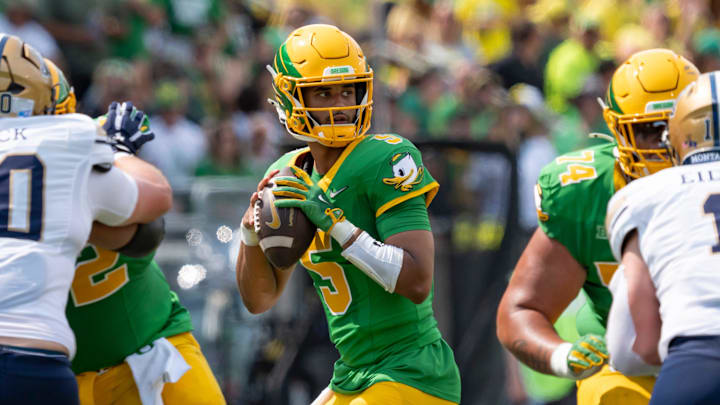1. Roles and rotations
Dan Lanning and the Oregon coaching staff took a bold approach to their Week One game against Montana State.
The Ducks won 59-13, and they played 78 guys, including 29 freshmen and redshirt freshmen. They played four different quarterbacks and seven different running backs. On defense, they used five safeties and six different cornerbacks.
In Big Ten conference play and neutral site games, the roster limit is 74. Rotations are sure to tighten up. Right now after stacking three top ten recruiting classes the staff has maximum confidence in this roster and a total commitment to developing it. They are mixing and matching on the offense line.
Some of these rotations are sure to tighten up. Dan Lanning isn't going to tell the press what the plan is. He's been deliberately vague about Makhi Hughes' role. Against MSU Oregon threw to 10 different receivers.
2. Who does Dante Moore trust?
In interviews Dante Moore will express appreciation and confidence in every one of the Oregon receivers, even guys like Cooper Perry and Kyler Kasper who haven't yet established themselves. But what about in the heat of a game, a close game where the opponent is more competitive?
That answer won't be revealed until the Ducks play Penn State, not definitively. Oregon has four games to experiment and tighten up the rotations. They're beating Oklahoma State, Northwestern and Oregon State by three or more touchdowns. Penn State, Indiana, Iowa and Minnesota is another level of competition from these early games. For now, the experiment will continue and the depth chart is secret.
Dakorien Moore, Malik Benson, Gary Bryant Jr. posted a 100% catch rate in 12 targets against the Bobcats. Jeremiah McClellan was targeted once, a completion for 13 yards. That feels like the four, but Perry, Kasper and Justius Lowe are all hard workers with potential.
Off the bench Jay Harris broke for a big play on a Texas route against a blitz, 50 yards. Austin Novosad hit Kasper with a 40-yard bomb down the right sideline, a ball that was underthrown but a big play.
In spite of the 28.5-point spread Game Two should tell Duck fans more about roles and who has the focus to make plays on Saturdays. It should offer more clarity about what kind of offense this can be.
3. Offensive line efficiency
The raw production numbers were good in the MSU game, eye-popping even. The Ducks didn't allow a sack and didn't have a negative play until the kneel-down at the end. The running game cranked out 253 yards on 39 carries, 6.5 per rush. The Ducks averaged 7.9 yards per play.
Alex Harkey was one of my favorite OT➡️OG conversions I saw over summer at Texas State. Even more so now after his first action for Oregon
— Mike Renner (@mikerenner_) September 3, 2025
327-pounder with nimble feet that can generate power pic.twitter.com/jccfrCW2TB
Yet some of that wondrous efficiency has to be credited to the physical advantage Oregon owned in the game and runners and receivers breaking tackles. In Addicted to Quacks film review, Tristan found an error rate of 25.66 percent for the offensive line in run blocking. Inside runs only averaged 4.0 yards per play; the Ducks made big gains exploiting their talent and speed advantage running outside.
The unit posted a Pro Football Focus pass blocking grade of 93 for the opener against a smaller, less athletic FCS defensive line. Some of the run blocking grades were much lower, though Alex Harkey posted an 84.5, tops on the team.
Oklahoma State's defensive Front 7 is much improved from a year ago under new coordinator Todd Grantham. Against UT-Martin they racked up four sacks and 9 tackles for loss while giving up just seven points, but again, that's against an FCS school.
Some OSU jersey numbers, first-game production, heights and weights:
5 LB Bryan McCoy 14 tackles 6-0 225
6 LB Brandon Rawls 11 tackles 6-0 240
95 DE Jaleel Johnson 5 tackles, 2.5 TFL 6-5 265
96 DT De'Marion Thomas 4 tackles 6-2, 337
4 LB Wendell Gregory 3 sacks 6-3, 255
87 DE DeSean Brown 2 tackles 6-2, 275
94 Armstrong Nnodim 1 tackle 6-2 290
In size and talent, the Cowboys are a step up in the Front 7 from a Big Sky opponent, but nowhere near the challenge Oregon will face against PSU on September 27 when they face Zane Durant, Dani Dennis-Sutton and Amare Cooper. Hand placement, footwork and execution have to improve, or the Oregon offense will grind to a halt in conference play.
The difference between 9-3 and 10-2 or better lies in the details of technique, consistency and execution. The Ducks will be big favorites in all four of their early games, but they have to continue to measure themselves against a much higher standard.
